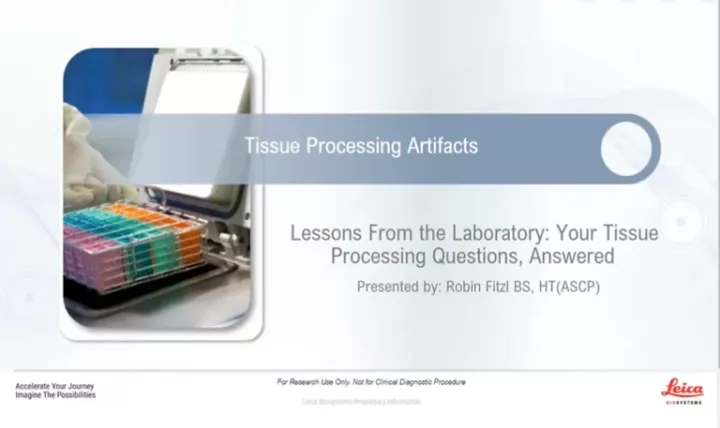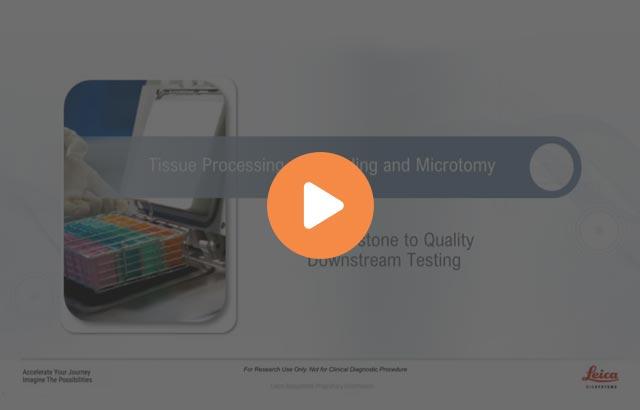Lessons From the Laboratory: Optimizing Your Tissue Processing

Have your research results or laboratory processes been bogged down by poor staining quality of histology slides? We all know that proper tissue processing is a key element to downstream staining quality, but do you know how to properly assess if your laboratory’s tissue processing is effective?
In this webinar, Senior Field Applications Specialist Robin Fitzl shares insights gleaned from her years of experience in the histology laboratories. Learn from Robin as provides insights via example of “what good looks like” in proper tissue processing, shares tips on what is “Optimal and Not”, and guide practitioners in obtaining high-quality staining results by optimizing tissue processing.
Learning Objectives
At the conclusion of this session, participants will be able to:
- Discuss Pre-Analytics and the impact of delayed fixation and artifacts on tissue processing
- Discuss fixation and the impact of incomplete fixation on tissue processing
- Describe elements of proper prosection
- Determine satisfactory processing of samples
- Explain why routine maintenance is a critical success factor to proper tissue processing
Webinar Transcription
Slide 1
Welcome
Slide 2
Slide 3
- Discuss Pre-Analytics and the impact of improper fixation and artifacts on tissue processing
- Discuss Fixation and the impact of incomplete fixation on tissue processing
- Describe the impact of improper Prosection
- Determine satisfactory Processing of samples
- Explain why routine Maintenance is a critical success factor to proper tissue processing
Slide 4
This slide has two examples of what the ideal sections in a perfect world look like under the scope. The skin section on the left is clean looking with the Eosin staining the components of the dermis with different shades. The colon section on the right is crisp with well-defined nuclei and cilia. There is no background staining or muddiness to the stain.
Slide 5
One artifact seen the lab that is not uncommon is crush artifact. The lung section on the left is architecturally preserved while the section on the right has mild compression at the bottom center. The staining although not ideal, is ok, but you cannot see the alveolar sacs like you can on the left. They could be cause by blunt forceps. One way to optimize this is to use care when handling all tissues.
Slide 6
Another example of crush artifact but more serious is on the right compared the lung section again that is ideal.
Slide 7
Another example of crush artifact but more severe is on the right compared the lung section again that is ideal. The top left region is so severe that it appears to exhibit nuclear streaming.
Slide 8
An artifact that is commonly seen is cauterization. You can see a normal section of breast on the left that show connective tissue staining evenly, while on the right, the section near the top center is darker. If you were able to go down on higher power the nuclear detail would either be absent or unclear. To optimize for this: …cauterization oftentimes cannot be controlled in histology as it is part of the surgical resection procedure to remove tissue, but it is good to recognize it.
Slide 9
An artifact common in the research world are perfusion artifacts. I know that this is a technique is vital to whole organ fixation in research and for optimal results, care must be taken to avoid architectural damage to the tissue.
Slide 10
The next two slides will demonstrate the results of little or no fixation and results in autolysis. The section on the left is a beautiful section of kidney. Optimal sections show: Here the components of the renal corpuscle such as the glomerulus and Bowman’s capsule are easily appreciated. In contrast, the kidney section on the right where the architecture is persevered, but cellular details are scant. This would be considered mild autolysis because there are areas where nuclei can be seen.
Slide 11
Here we have a nice section of liver on the left. This is optimal because it shows…..hepatocytes with nuclei that have well-defined nucleoli and sinusoids containing RBC’s. While the section of liver on the right is an example of severe autolysis. Cellular detail is absent, and the architecture is faint.
Slide 12
Let’s move on to another artifact that deals with contamination. The next three slide will show examples of such. On this slide the brain section is contaminated with plant material.
Slide 13
On this slide the section of lung is contaminated with a section of liver.
Slide 14
Here we have a section of cardiac tissue contaminated with a small fragment of thyroid. To optimize all these contaminant scenarios shown today, it is best avoid these types of contamination altogether by keeping dissection tools and the space where dissection is occurring clean.
Slide 15
Formalin pigment is an artifact that occurs when unbuffered NBF is not fresh or buffered. To optimize for Formalin Pigment, use fresh, buffered NBF at a pH of 7.2
Slide 16
This is a section of properly decalcified and well stained bone. Optimal characteristic seen here are: even section showing well-defined structures such as the compact bone and marrow.
Slide 17
Contrasting that to a section is under-decalcified results in a thicker area that stains darker.
Slide 18
Of course, the opposite of under decalcification is over-decalcification. The section on the right is unsatisfactory due to the absence of cellular detail. Over decalcification also adversely affects IHC as kappa/lambda would not work with this section. To optimize for over decalcification, I suggest: being aware that decalcification requires the use of chemicals that can be harsh but required to obtain histology sections. Careful monitoring of the process is needed to preserve cellular detail but also the integrity of sites such as kappa/lambda.
Slide 19
Let’s do a little quiz! Can you tell me what would cause these artifacts?
Slide 20
In the histology lab, when tissue is submitted for processing, the cassettes are designed to hold sections that are no more than 2.5 x 2 cm in length and width. The thickness should not exceed 3mm. Here, the section appears to have the correct length and width, but the cross-hatching of the section indicates that the section was too thick.
Slide 21
Sponges in the cassettes are sometimes necessary for tissue that is very small or is mixed with blood or mucus. But sponges can also cause artifacts as seen here.
Slide 22
This is a beautiful section of colon that I will reference in several slides. Again, the cellular detail is great, I can even see the cilia. It is clean and crisp.
Slide 23
In order to get sections that turn our great in the previous slide, fixation is one key ingredient. The standard rule is 20 parts fixative to 1-part tissue.
Slide 24
Even if you get the ratio right, with organs that have a cavity, it is important to prep those cases so that the fixative has access to every area. You can see here that the uterus was not opened.
Slide 25
This is the result identified as zonal fixation. A good section will show: Grossly, one can see that the outer half is formalin fixed while the inner half is not. The section of endometrium on the left has been evenly fixed while the endometrial section shows focal autolysis. For optimal results: always open hollow organs and prep larger specimens to allow for exposure to the fixative.
Slide 26
So we know that shrinkage occurs at every stage of processing but the harshest by far is ethanol. Here is the result of tissue not being completely fixed by formalin and then being placed in alcohol. The sections on the left are examples of ideal liver and kidney. On the right, these sections have been “fixed” in alcohol. There is excessive shrinkage and hardness of the tissue which results in darker staining (difficult to cut at 4-5 microns). Loss of bound water.
Slide 27
NBF and alcohol above 73%
Slide 28
Great section of colon because it shows: section of bowel that is clean and crisp with no overstaining. The nuclei are easily seen near the base of the cells.
Slide 29
When tissue is over-dehydrated, of course shrinkage and loss of bound water can occur. The sections are then more difficult to cut and hydration with water is needed. These sections of bowel show chatter and sometimes darker staining. Take note that this section can represent more than one root cause.
Slide 30
Remember that the section on the left is what we’re going for! It has crisp staining with well-defined nuclei and cilia compared to The section on the right is an example of severe over-dehydration that has not only resulted in chatter and darker staining but artifactual spaces.
Slide 31
Here is that super section of bowel that shows the colon section on the right is crisp with well-defined nuclei and cilia, signs of proper hydration on the left compared to a section that has been under dehydrated. You can that the staining is murky, not well-defined. This is because there is free water still present. Take note that this section can represent more than one root cause.
Slide 32
Let’s talk about clearing, remember this is the ideal section we want. This section shows section of bowel that is clean and crisp with no overstaining. The nuclei are easily seen near the base of the cells.
Slide 33
When tissue is over-cleared, shrinkage and loss of bound water can also occur. That is because if xylene is used, it has a dehydrating characteristic like alcohols. The sections are then more difficult to cut and hydration with water is needed. These sections of bowel show chatter and sometimes darker staining. Take note that this section is the same one I previously discussed. To optimize these common problems, I suggest…being mindful of which protocol to use. Modify protocols steps to minimize over-dehydration by introducing more graded alcohols, reducing heat temperatures on certain steps.
Slide 34
Remember that the section on the left is what we’re going for! The section on the right is an example of severe over-clearing that has not only resulted in chatter and darker staining but artifactual spaces. Again, if xylene is used, it has a dehydrating characteristic like alcohols. The sections are then more difficult to cut and hydration with water is needed. These sections of bowel show chatter and sometimes darker staining. Take note that this section is the same one I previously discussed. To optimize, I suggest being mindful of which protocol to use. Modify protocols steps to minimize over-dehydration by introducing more graded alcohols, reducing heat temperatures on certain steps.
Slide 35
Here is that super section of bowel on the left compared to a section that has been under-cleared. You can that the staining is murky, not well-defined. This is because there is free water still present. Take note that this section can represent more than one root cause.
Slide 36
Let’s talk about wax infiltration, remember this is the ideal section we want. This section shows… section of bowel that is clean and crisp with no overstaining. The nuclei are easily seen near the base of the cells as a sign of optimal tissue processing.
Slide 37
Here is that super section of bowel on the left compared to a section that has been under-infiltrated with wax. You can that the staining is murky, not well-defined. This is because there is xylene still present. One suggestion to optimize this could be…increasing the paraffin infiltration times. Ensuring that reagent maintenance is being followed. Take note that this section can represent more than one root cause.
Slide 38
Let’s talk about Maintenance, remember this is the ideal section we want. I’ve saved the best for last because this unfortunately is an area is so often dismissed. Remember, optimal histology is what we targeting, right?
Slide 39
Do these seem familiar? Yes! That’s because if proper maintenance is not performed, residual water, dehydrants and clearants can cause this type of poor histology. As a final suggestion, working you’re your FSA and performing regularly scheduled preventive maintenance could optimize these processes.
For Research Use Only. Not for Use in Diagnostic Procedures.
Related Content
Leica Biosystems content is subject to the Leica Biosystems website terms of use, available at: Legal Notice. The content, including webinars, training presentations and related materials is intended to provide general information regarding particular subjects of interest to health care professionals and is not intended to be, and should not be construed as, medical, regulatory or legal advice. The views and opinions expressed in any third-party content reflect the personal views and opinions of the speaker(s)/author(s) and do not necessarily represent or reflect the views or opinions of Leica Biosystems, its employees or agents. Any links contained in the content which provides access to third party resources or content is provided for convenience only.
For the use of any product, the applicable product documentation, including information guides, inserts and operation manuals should be consulted.
Copyright © 2025 Leica Biosystems division of Leica Microsystems, Inc. and its Leica Biosystems affiliates. All rights reserved. LEICA and the Leica Logo are registered trademarks of Leica Microsystems IR GmbH.



